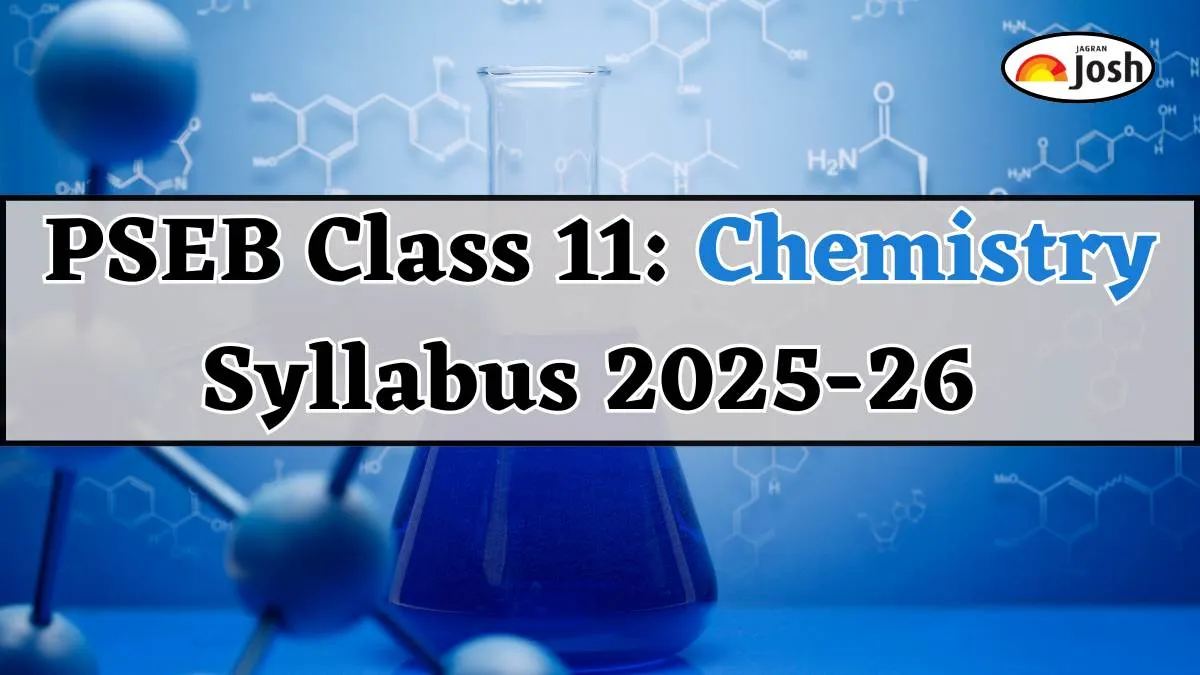The Punjab Board's 2025–2026 Class 11 Chemistry Syllabus includes a detailed description of the topics covered in each chapter as well as the substance of the practical test. The key concepts and topics that will be covered throughout the academic year are listed in the syllabus. Each of the twelve units' topic-by-topic split and marking scheme are discussed. The program also includes practical assessments to assess students' laboratory skills. Review the whole syllabus to familiarize yourself with the most recent course structure and to ensure that you are well prepared for the PSEB Class 11 Chemistry Exam 2025–2026.
PSEB Class 11 Chemistry Syllabus: Key Highlights
| Board Name | Punjab School Education Board (PSEB) |
| Class | 11 |
| Subject | Chemistry |
| Total Marks | 100 |
| Theory Marks | 70 |
| Practical Marks | 25 |
| Internal Assessment | 05 |
| Paper Duration | 3 Hours |
PSEB Class 11 Chemistry: Detailed Syllabus 2025-26
Check the table below to know the full syllabus of Punjab Board Class 11 Chemistry:
| Unit I: Some Basic Concepts of Chemistry 12 Periods
|
| Unit II: Structure of Atom 14 Periods Bohr's model and its limitations, concept of shells and subshells, dual nature of matter and light, de Broglie's relationship, Heisenberg uncertainty principle, concept of orbitals, quantum numbers, shapes of s, Pauli's exclusion principle and Hund's rule, electronic configuration of atoms, stability of half-filled and completely filled orbitals. |
| Unit III: Classification of Elements and Periodicity in Properties 8 Periods Modern periodic law and the present form of periodic table, periodic trends in properties of elements-atomic radii, ionic, inert gas radii, ionization enthalpy, electron gain enthalpy, electronegativity, valency. Nomenclature of elements with atomic number greater than 100 |
| Unit IV: Chemical Bonding and Molecular Structure 14 Periods Valence electrons, ionic bond, covalent bond, bond parameters, Lewis structure, polar character of covalent bond, covalent character of ionic bond, valence bond theory, resonance, geometry of covalent molecules, VSEPR theory, concept of hybridization, involving s, p and d orbitals and shapes of some simple molecules, molecular orbital theory of homonuclear diatomic molecules (qualitative idea only), hydrogen bond. |
| Unit V: Chemical Thermodynamics 16 Periods Concepts of System and types of systems, surroundings, work, 2025-26 heat, energy, extensive and intensive properties, state functions. First law of Thermodynamics internal energy and enthalpy, heat capacity and specific heat, measurement of <U and <H, Hess's law of constant heat summation, enthalpy of bond dissociation, combustion, formation, atomization, sublimation, phase transition, ionization, solution and dilution. Second law of Thermodynamics (brief introduction). Introduction of entropy as a state function, Gibb's energy change for spontaneous and non-spontaneous processes, criteria for Equilibrium. Third law of thermodynamics (brief introduction). |
| Unit-VI: Equilibrium 14 Periods Equilibrium in physical and chemical process, dynamic nature of equilibrium, law of mass action, equilibrium constant, factors affecting equilibrium-Le Chatelier's principle, ionic equilibrium-ionization of acids and bases, strong and weak electrolytes, degree of ionization, ionization of poly basic acids, acid strength, concept of pH, Henderson Equation, hydrolysis of salts (elementary idea), buffer solution, solubility product, common hydrolysis of salts (elementary idea), buffer solution, solubility product, common ion effect (with illustrative examples). |
| Unit VII: Redox Reactions 06 Periods Concept of oxidation and reduction, redox reactions, oxidation number, balancing redox reactions, in terms of loss and gain of electrons and change in oxidation number, applications of redox reactions. |
| Unit VIII: Organic Chemistry-Some Basic Principles and Techniques 14 Periods General introduction, methods of purification, qualitative and quantitative analysis, classification and IUPAC nomenclature of organic compounds. Electronic displacements in a covalent bond: inductive effect, electromeric effect, resonance and hyper conjugation. Homolytic and heterolytic fission of a covalent bond: free radicals, carbocations, carbanions, electrophiles and nucleophiles, types of organic reactions. |
| Unit IX: Hydrocarbons 12 Periods Classification of Hydrocarbons Aliphatic Hydrocarbons:
|
PSEB Class 11 Chemistry: Practical Syllabus 2025-26
| Evaluation Scheme for Examination | Marks |
| Volumetric Analysis | 07 |
| Salt analysis | 07 |
| Content Based Experiment | 05 |
| Project Work | 03 |
| Class record and viva | 03 |
| Total | 25 |
To Download PSEB Class 11 Chemistry Syllabus 2025-26, Click the link below
PSEB Class 11 Chemistry Syllabus 2025-26: Download PDF
Also Check:
PSEB Class 11 Accountancy Syllabus 2025-26
PSEB Class 11 Biology Syllabus 2025-26
PSEB Class 11 Business Studies 2025-26
